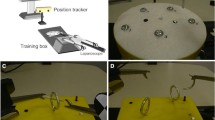Abstract
Purpose
To demonstrate the possibility of laparoscopic technique training and refinement at the millimetric level.
Material and Methods
A physical trainer and Winstar rats were used.
Results
The training system is visually similar to pneumoperitoneum. The laparoscopic technique is perfected in a visual space illuminated by white light, with two-dimensional feedback and at a geometric level that allows for refinement of the technique.
Conclusions
It is possible to refine the technique at this geometric level at a low cost and without requiring laparoscopic equipment. In addition, optics tests indicate the possibility in the short term of refining the laparoscopic technique to the microanastomotic level.






Similar content being viewed by others
References
Ali MR, Mowery Y, Kaplan B, DeMaria EJ (2002) Training the novice in laparoscopy. Surg Endosc 16:1732–1736
Berguer R, Gutt C, Stiegmann GV (1993) Laparoscopic surgery in the rat Description of a new technique. Surg Endosc 7:345–347
Gutt L, Kim CN, Krähenbühl Z-G (2002) Training for advanced laparoscopic surgery. Eur J Surg 168:172–177(6)
Hamilton DJ, Scott JB, Fleming RV, Rege R, Laycock PC, Bergen ST, Tesfay DB Jones (2002) Comparison of video trainer and virtual reality training systems on acquisition of laparoscopic skills. Surg Endosc 16:406–411
Berber E, Berber I, Avtan L, Ata B, Azamak A, Avci C (2002) Laparoscopic vagotomy using mini-instruments in the rat: A new laparoscopic small animal model. Surg Today 32:498–502
Marcel P, Galesso cuck, Marcio R Pagan, Fernandez, Marjo DC Perez, Flavio CS (2002) Botter Brazilian laparoscopic orchietomy: experimental rat model. J Urol 28:143–146
Chousleb E, Chousleb A, Shchleib S, Hernandez Baro M (2003) Microcirugía laparoscopica empleando el sistema Aesop y la rata como modelo experimental. Revista Mex Cirugía Endosc 4:111–114
Kuntz C, Kienle P, Schmeding M, Benner A, Autschbach F, Schwalbach P (2002) Comparison of laparoscopic versus conventional technique in colonic and liver resection in a tumor-bearing small animal model. Surg Endosc 16:1175–1181
Koh CH, Janik GM (1999) Laparoscopic microsurgery: Current and future status. Curr Opin Obstr Gynecol 11:401–407
Berguer, Cornelius T, Dalton M (1997) The optimum pneumoperitoneum pressure for laparoscopic surgery in the rat model A detailed cardiorespiratory study. Surg Endosc R. 11:915–918
Acknowledgements
We would like to thank Dr. Ismael Jiménez of the Physiology Department of the CINVESTAV for his valuable comments and the facilities he provided to test the training system.
Author information
Authors and Affiliations
Corresponding author
Rights and permissions
About this article
Cite this article
Martinez, A.M., Kalach, A.C. & Espinoza, D.L. Millimetric laparoscopic surgery training on a physical trainer using rats. Surg Endosc 22, 246–249 (2008). https://doi.org/10.1007/s00464-007-9658-1
Received:
Revised:
Accepted:
Published:
Issue Date:
DOI: https://doi.org/10.1007/s00464-007-9658-1




